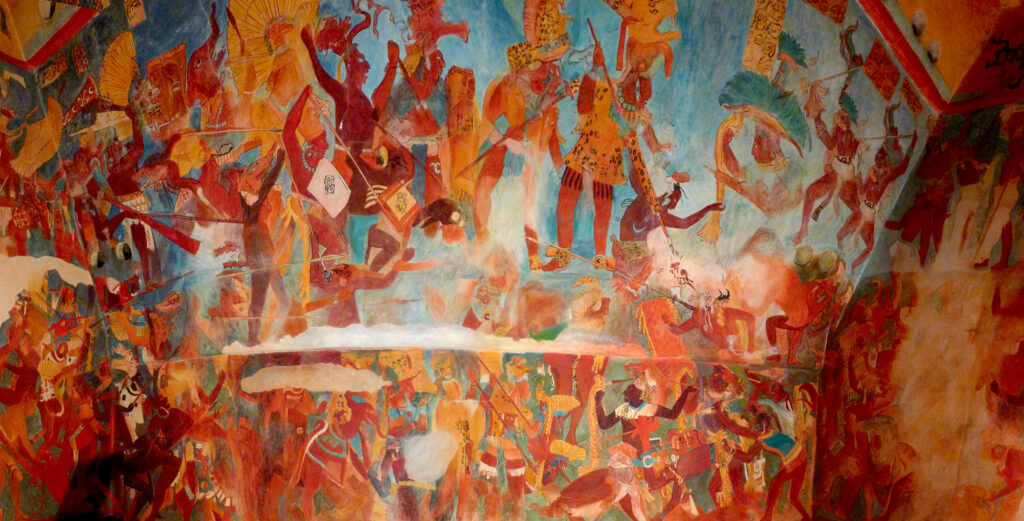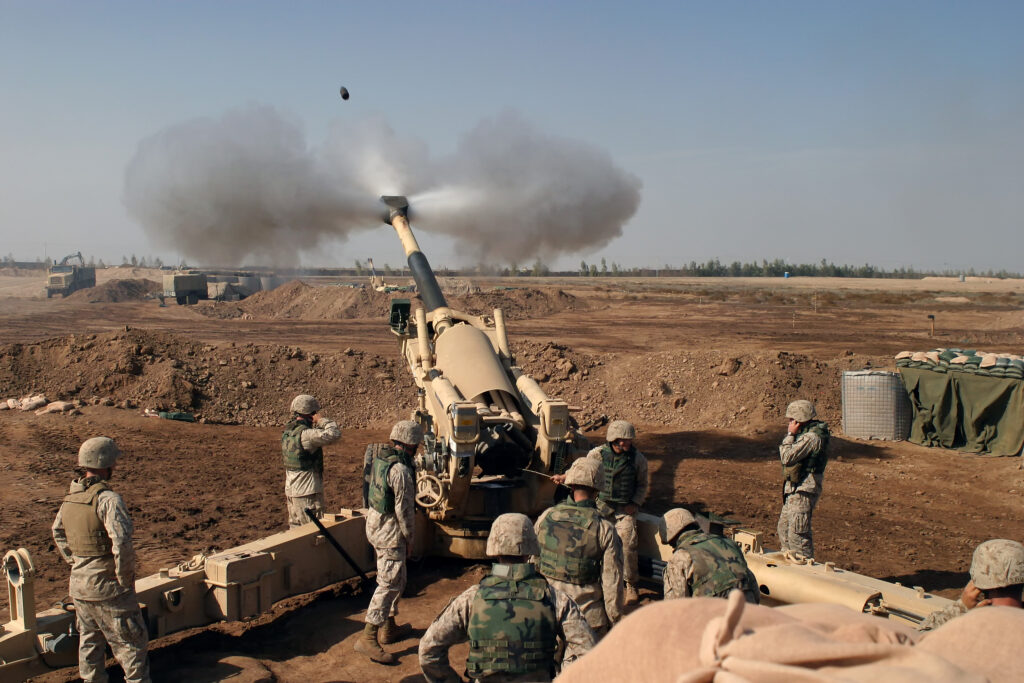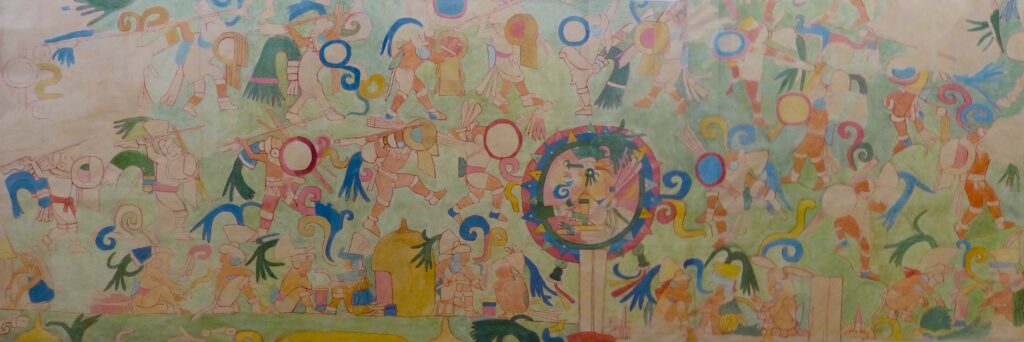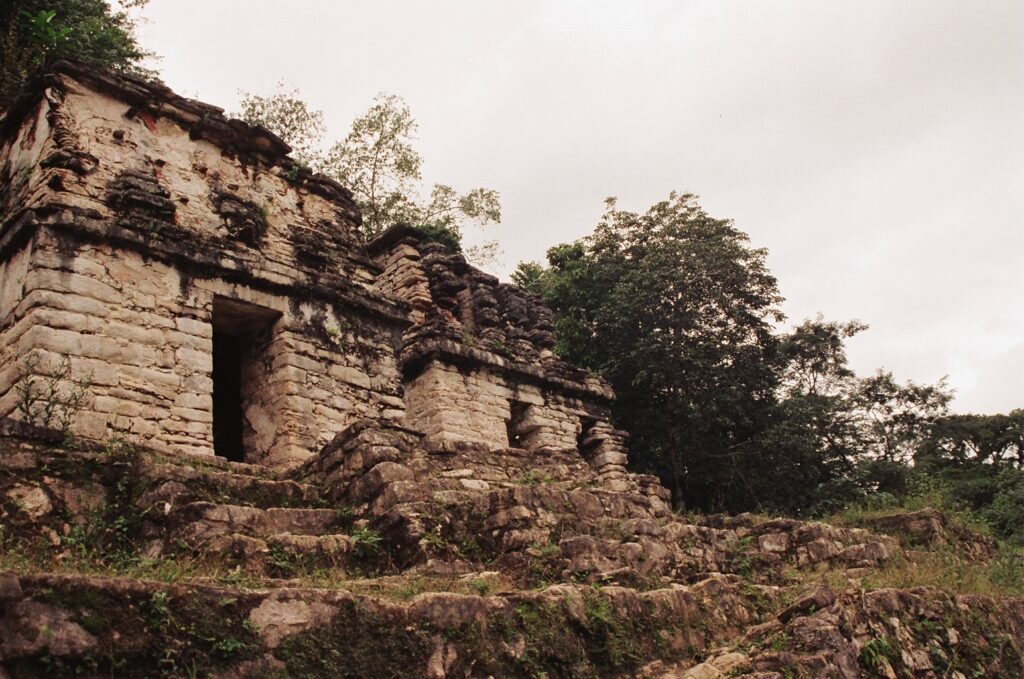Is War Inevitable? Consider the Ancient Maya

Arresting trails of light arc across the night sky, exploding into clouds of smoke. Blasts collapse buildings, jettisoning plumes of dust. We see these scenes over and over—in Ukraine, Syria, and around the globe—and the violence triggers questions: How many people were injured or killed? What caused this to happen? Why is there so much conflict today? Is war a deeply rooted part of the human experience?
As a college freshman, I (Bracken) “celebrated” my birthday watching breathless media coverage of the March 2003 U.S. invasion of Iraq. Though President George W. Bush declared “mission accomplished” six weeks after the start of the invasion, the war spiked to even deadlier levels in 2004 with the Battle of Fallujah. I (Hernández) turned 18 a few months later. Though neither of us has served in the military, growing up amid the United States’ “forever wars” has driven us to try to answer questions about social conflict.
As archaeologists, we can examine when and where war first occurred and how war has impacted the human experience. These questions remain hotly debated. Often selectively drawing from the archaeological literature, many claim that humans are becoming increasingly peaceful, while others counter that we are more violent than ever.
A fundamental issue at play is that the archaeological evidence for war is often unclear and can be interpreted in multiple ways. Battle-related deaths can be difficult to distinguish with certainty from deaths caused by bodily trauma unrelated to warfare. A cracked skull or broken arm can result from martial combat, an interpersonal dispute, or an accident.
We argue that one solution is a greater focus on “martial practice,” meaning social processes and human behaviors surrounding war, including questions about fighting styles, weaponry, armor, wound types, and interactions with the landscape.
In an upcoming special section for the journal Ancient Mesoamerica, we and other researchers show that homing in on martial practice—with both cutting-edge techniques and traditional methods—allows for more effective interpretation of the evidence. Using these approaches, researchers are coming to a deeper and more nuanced understanding of war across the human experience.
ARCHAEOLOGY AND BIG QUESTIONS ABOUT WARFARE
Euro-American scholars have long debated the frequency of war in the past, motivated in part by colonial encounters with Indigenous and local communities. Often, their goal has been to determine whether humanity is inherently peaceful or violent. At stake is either a justification or a condemnation of ongoing wars, imperialism, and violence in general.
Perhaps the most prominent recent contributor to this debate is experimental psychologist Steven Pinker. In his bestselling 2011 book, The Better Angels of Our Nature, Pinker contends that our current moment, despite world wars and constant conflicts, is the most peaceful in human history. Yet in their bestselling 2021 book, The Dawn of Everything, archaeologist David Wengrow and the late anthropologist David Graeber highlight the flaws in Pinker’s argument (as many other researchers have done). They emphasize that Pinker’s perspective is an academic justification for European colonialism that masks a more complex and interesting reality.
The backbone of much of Pinker’s argument derives from archaeologist Lawrence Keeley’s 1996 book War Before Civilization. Keeley, one of my (Hernández’s) undergraduate mentors, includes archaeological data in the book when possible. But he admits his ideas about past warfare require more rigorous archaeological research and additional data from a variety of regions around the world.
Studies of warfare in archaeology have surged since the 1990s, due in large part to debates sparked by War Before Civilization. In his book War!: What Is It Good For?, archaeologist Ian Morris claims, similar to Pinker, that humanity has been made safer and richer by victorious communities of sedentary farmers who “came, saw, conquered, and administered.”
Archaeology has been hindered by a lack of focus on the strategies, tactics, bodily techniques, and logistics of war.
However, Morris also notes there is a lack of reliable data on battle deaths prior to A.D. 1500 around the world. This includes Mesoamerica, our own area of study. Such data could shed light on the levels of violence in Mesoamerica prior to European colonization. Morris argues that “what we need is a Mesoamerican Tacitus [an ancient chronicler] who would tell us what was going on.”
No one has yet found a single ancient Mesoamerican text containing the rich ethnographic detail reminiscent of Tacitus’ writings. However, recent work in Maya historical archaeology and cutting-edge analytical techniques are opening new avenues of study—including a focus on the practice of war.
INVESTIGATING “MARTIAL PRACTICE” IN THE PAST
To explore the origins and impact of war, we begin by unpacking what war means in practice. This involves investigating the complex actors who participated in past wars, plus their aims and strategies, tactics, weaponry, armor, etiquette, modes of commemoration, and interactions with their landscapes. For example, we ask: How do people work with terrain to create fortified communities that funnel movement to particular places, such as grandiose plazas with monuments that glorify warriorhood? More on this later.
A focus on “practice” also offers insight into the creative aspects of human activity. After all, what people do shapes the dynamics of culture and the world around them. We apply this conceptual focus to understand the lives of past Mayas who lived in what is now Mexico and Central America.
Once-prevalent notions of a peaceful ancient Maya civilization have faded over the past 70 years in the wake of finds of fortifications, weaponry, skeletal trauma, destructive episodes at settlements, and art depicting martial themes. In addition, researchers have deciphered Maya hieroglyphic writing and learned that war is one of the most common events discussed on monuments.
In the last decade or so, researchers have also made major breakthroughs in settlement mapping through aerial lidar—the use of laser scanners mounted on airplanes. Using aerial lidar mapping, researchers have detected architecture hidden beneath dense rainforest, revealing fortifications on an unprecedented scale.
Despite these breakthroughs, many investigators agree that far more work is needed to explore ancient forms of combat, the use of weaponry, and the logistics necessary to muster armed forces in the hundreds and even thousands. Such insights into how ancient Mayas waged war will allow future investigators to better identify skeletal trauma caused by martial combat and to form a more accurate picture of past war-making.
In this vein, bioarchaeologists Vera Tiesler and Andrea Cucina examined the remains of 1,103 individuals from different parts of Mexico and Central America, searching for evidence of cut marks, blunt-force trauma, and other injuries. They observed a roughly even distribution of injuries across the left and right side of the front cranium.
According to the authors, these results do not support the presence of standing armies in the pre-Columbian past. The researchers reason that standing armies would have engaged primarily in hand-to-hand combat, and the dominance of right-handedness would result in a higher proportion of impacts to the left side of the front cranium.
Tiesler and Cucina acknowledge that little is known about the tactics employed by ancient Mayas, so their assertion awaits further research. Nevertheless, their work highlights how the study of martial practice can enrich our understanding of Maya skeletal remains, informing investigation into broader questions about social conflict.
WAR DOES NOT EQUAL COMBAT
Within the Mesoamerican cultural context, we have analyzed how ancient Mayas prepared for and engaged in combat, and how they administered the outcomes of war. This framework breaks our investigation away from simplistic notions of “war equals combat.” Instead, we consider how the process of making war pervades different aspects of the human experience. We draw upon multiple lines of converging evidence to build conclusions and deploy this approach in the special section for Ancient Mesoamerica.
Bracken utilized geographical information system (GIS) computational methods to model the likely walking routes across the ancient landscape of Muralla de León, Guatemala—a site enclosed by a stone wall of varying height and thickness. He used statistical analysis to compare the slope of the terrain and other GIS measures of accessibility. The results revealed a tendency for the walls to be taller and thicker in areas that would have been more easily traversed on foot. This indicates that ancient Mayas were concerned about incursions into the interior of Muralla de León and invested heavy labor in defending the site. Future research will provide clues into Maya weaponry and defensive combat plans.
Hernández also assessed how ancient Maya combined fortifications with hydrology and mountainous terrain to create layers of defense at Tzunun, Chiapas, Mexico, a peninsular site occupied around the time of Spanish colonization. Based on colonial records from A.D. 1520–1800, Mayas likely defended Tzunun through a combination of warriors fighting with hand-to-hand and projectile weapons on land and in canoes.
Spanish conquistador Martín de Ursúa y Arizmendi described such a strategy in 1697. While preparing for a final assault upon the island community of Nojpetén, the capital of the Itza Mayas, he wrote, “They [Itzas] came with a considerable number of canoes in order to create warlike displays, situating their forces on the water, as they were accustomed to it.”
Also in the special section, art historian Caitlin Earley explores how past Maya people moved through and experienced landscapes. She analyzes imagery and written records to determine how elite Maya warriors’ identities were shaped by viewing and interacting with monuments that depict captives from battles. For past Mayas, stone monuments were far from passive props. They were alive and the literal embodiment of captives. “Carved stone monuments,” Earley states, “conveyed information about the outcomes of warfare—but they also helped to prepare for battle by communicating with elite viewers about their roles, both political and ritual.”
In addition, art historian Mary Miller examines colonial records and the murals of Bonampak (a Maya archaeological site in Chiapas, Mexico) to deduce combat techniques and tactics in the Classic period, from A.D. 200–900. These include dawn attacks, temple burning, teams of warriors taking captives, and combatants using overwhelming force to achieve victory. Miller’s research, along with the other papers mentioned above, illustrates the diversity and dynamics of martial practice among ancient Mayas.
THE FUTURE OF STUDIES ON WAR
The study of martial practice also holds great promise for other parts of the world. Anthropological archaeologist Nam Kim has investigated fortifications at Co Loa in Vietnam to understand how warfare emerged in this region of Southeast Asia. In the special section, Kim and colleagues lay out a path forward for the study of warfare among ancient Mayas and beyond. They demonstrate how cross-cultural analysis can be paired with a study of martial practice.
Furthermore, they recognize that war-related trauma is underrepresented in the skeletal record. As in contemporary society, more Mayas likely experienced the effects of war-making—for example, displacement, captivity, and food shortages—rather than directly participating in combat. Such wide-ranging societal impacts, often overlooked, supply all the more reason to employ multiple methods and technologies to analyze the archaeological evidence.
Archaeology is a powerful lens for understanding humanity, but we contend the field has often been hindered by a lack of focus on the strategies, tactics, bodily techniques, and logistics of war. This oversight tends to be greatest for cultures that fall outside of military history in Europe, the Middle East, and Northern Africa. We argue that shifting the focus toward these practices highlights the human element in the study of war, allowing for richer interpretations of skeletal trauma and other potential traces of past social conflict.
More broadly, this approach reframes the way people think about war and peace. Understanding the practical side of war means that a lack of fortifications can no longer be interpreted as a straightforward indication of peaceful interactions between neighbors. Preparing a community for war by constructing martial architecture would have involved multiple factors, including tactics, labor, resource procurement, and a lengthy duration of settlement. These burdens may have made fortifications too costly, especially for mobile or semi-nomadic groups.
Only by taking these factors into account can we understand the potential origins and impacts of war, which is fundamental to understanding the human experience.





































